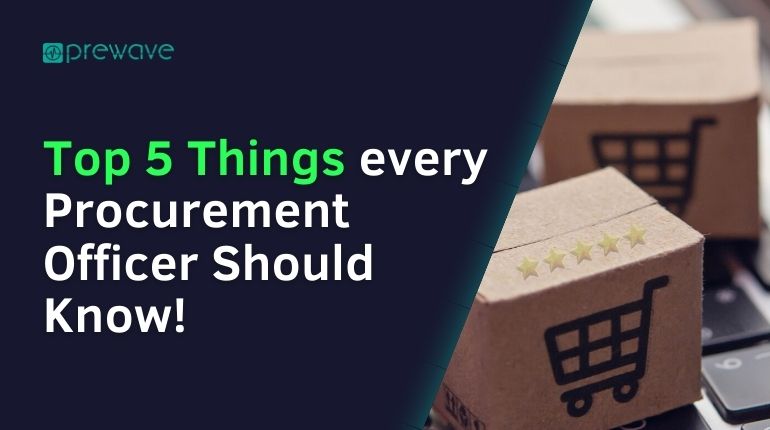If you have good communication, management, and negotiation skills—chances are, you’re a procurement officer. Which means that you are situated at the bottom of the organisational pyramid: one wrong move and everything comes toppling down. This is because not only are you in charge of creating and maintaining relationships with suppliers, you’re also estimating and establishing budgets, maintaining purchase records, negotiating contracts, developing purchase plans, ensuring product quality standards…and the list goes on.
As more responsibilities are piled onto your shoulders, procurement is starting to feel more of a juggling act than a profession. Only now, you also need to add adaptability to your daily “To do” list because the market has become more saturated than ever—and competition is at an all-time high.
So, as more companies prepare for a procurement-facing future, here are the top 5 things (in no particular order) you should know if you want to keep swimming with the tide—rather than against it.
Broadcast on all channels
When it comes to procurement, communication is key. This is because a big chunk of your day is spent communicating: trying to build connections, selling hard ideas, establishing goals, and even attempting to change an opinion or two.
Communication, however, goes beyond PowerPoint presentations, the average sales pitch, and impersonal emails. In the age of technology, with so many tools at your fingertips, you must work to adapt your communication channel to the audience you are trying to reach, whether this is someone within the organisation, or a potential vendor or supplier.
There is no longer a one-size-fits-all approach to communication. Rather, you must tune into the needs of whoever is on the receiving end of your message, and adapt accordingly.
Kiss Excel goodbye
The future of procurement remains ambiguous, but one thing is for certain: it will always meet basic organisational needs, such as sourcing and supplier selection. Recent advancements in technology, however, have started to change the way in which procurement is approached, primarily by automating manual processes—and turning supplier capabilities into a competitive advantage.
There is a growing need for procurement officers to keep up with recent technological advancements—which now include cloud-based platforms and analytically-driven approaches, to name a few—and embrace the change that comes with each. As your role begins to shift and transform, you must shift and transform with it, especially if you want to remain competitive. And look on the bright side: digital procurement processes will remove mundane, time-consuming tasks from your list of daily responsibilities, freeing up your schedule for value-driven, high-impact activities.
There is no procurement without risk
Procurement has changed significantly—from a cost-cutting process to a strategic one that has a direct impact on the bottom line. And with this change comes great risk, which demands a robust risk management strategy.
Are disruptions unavoidable? Yes. Should we still plan for and respond to them? Also yes.
We often make the mistake of classifying supply chain vulnerabilities as “unexpected”, which, in today’s technologically-advanced world, is open to interpretation—and can no longer justify poor risk management, or a lack thereof.
In short, you need to respond quickly and proactively to any disruption that may arise, which requires a better understanding of your supply chain—granular visibility across not just your direct suppliers, but all of their suppliers, as well. And technology can play a big role in helping you do just that.
The corona crisis showed us that risk is difficult to quantify—while also opening the door to solutions like Prewave’s Tier-N Monitoring, which helps manage future incidents by enabling you to react as quickly as possible, through a monitoring system that gives you information in real time.
With Tier-N Monitoring, you can map your entire supply chain and achieve full visibility—allowing you to plan for and respond to any disruptions.
It stands true that there is no procurement without risk, but having the right tools can significantly reduce the amount of risk your organisation is exposed to.
Book a demo to get started!
Collaboration will never go out of style
Technology, however, will never be able to replace the human factor in building and maintaining relationships, both internally (with other business units) and externally (with suppliers).
If you’re looking to move away from the traditional role of buyer by delivering strategic value to the business, recognising the benefits of collaboration—and incorporating it into your daily routine—is a good place to start. This is because internal collaboration has the potential to boost productivity, while external collaboration can significantly strengthen supplier relationships and reduce supply chain risks.
As you look to advance your own agenda—and embrace the role of strategist and advisor—pay attention to the people around you. What are their needs? Their concerns? Active listening is a crucial skill that can go a long way in fostering collaboration—thus ensuring long-term profitability for the business.
Keep an eye on the bigger picture
Procurement can often be one-dimensional, with most of your time and energy focused on reducing costs, obtaining quality goods, and managing cash flow. However, you should never lose sight of the bigger picture. In other words, what is the business trying to achieve long-term? What is the 5-year plan? The 10-year plan?
As businesses look to control costs while maximising output, you are often faced with the question of how to deliver results. The answer is: by defining the bigger picture, which will transform your approach to spending with forward-thinking practices like strategic sourcing, a practice that weighs the value delivered through vendor relationships, rather than the cost of a product or service. In other words, strategic sourcing is all about building long-term, strategic relationships and partnerships—and it’s just one of many practices aimed at establishing long-term goals in procurement.




